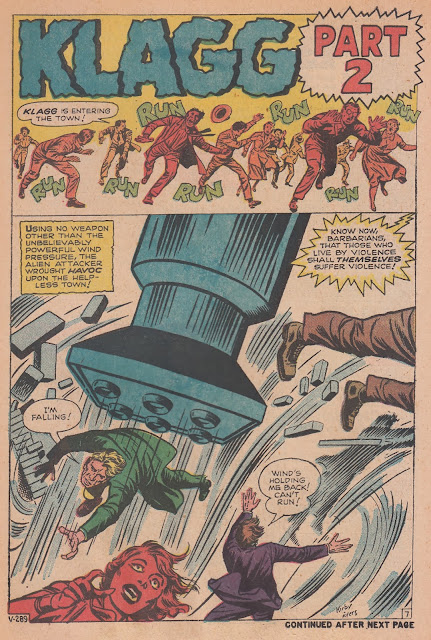I began with Where Monster Dwell #21 -- the issue that reprinted from Strange Tales #89 (October 1961) Marvel's most famous pre-superhero Silver Age monster, Fin Fang Foom! -- and worked my way up to Where Monsters Dwell #29. I took a break last weekend because I didn't have Where Monsters Dwell #30 and was unable to locate it online at Atomic Avenue. I was able to purchase several issues that preceded Where Monsters Dwell #21. So let's start working backwards from #21.
Where Monsters Dwell #20 (March 1973) is special because it features original cover art from the superhistoric Jim Starlin: rejuvenator of Captain Marvel and Adam Warlock; creator of Thanos, Drax the Destroyer and Shang-Chi, Master of Kung Fu:
Starlin took some liberties. The cover depicts a monstrous robot named Klagg delivering a beat-down on some GIs at the behest of an evil alien. In the Lee-Kirby story -- "Klagg! His Mission: Destroy Mankind!" originally appearing in Tales of Suspense #21 (September 1961) -- Klagg is the egg-headed alien who travels in a high-tech, clean-powered, wind-generated, robot-looking spaceship. Starlin for purposes of a suitably alluring Bronze Age cover turns the spaceship into a killer robot named Klagg!
"Klagg! His Mission: Destroy Mankind!" is another Lee-Kirby Cold War yarn. A highly-evolved alien lost in space lands on earth to get his bearings. Immediately there is competition among adversarial nations to acquire the amazing technology that powers Klagg's spaceship. When Klagg discovers that the people of Earth still believe in war he sets out to annihilate the planet so its bellicose contamination can't spread to the rest of the galaxy. A wealthy ne'er-do-well and his girlfriend elicit a reconciliation of Cold War foes by pretending to have stolen the blueprints of Klagg's futuristic, powerful spaceship and the secret to its propulsion. The combined military might of all nations face Klagg in a united naval force. Klagg is impressed by humanity's ability to cooperate and exits Earth.
Most of these Silver Age Lee-Kirby Cold War stories are the same. An alien, a monster of some sort, arrives from outer space and threatens the good, law-abiding folk with destruction. Somehow, like the loafing one-percenter in "Klagg!" who miraculously discovers his own maturity and saves the day, doom is averted in the last few panels.
People in the early 1960s were terrified that the Cold War was going to turn hot and incinerate the planet. Then you had the Cuban missile crisis in October 1962 followed by the Atmospheric Test Ban Treaty a year later and there was a bit of a thaw.
When you have that kind of tension, an inside and an outside are clear. Aliens -- outsiders -- are bad. Social cohesion is a must. Cultural conservatives would love to return to the days of the Cold War when it was widely understood who was on the inside and who -- "subversives" -- needed to be kept out. But those days aren't coming back. Bush tried following 9/11. "You're either with us or against us." But the enemy this time, Al Qaeda, not only doesn't stack up to the Soviet Union, it is actively maintained by our historic ally and owner of the largest petroleum reserves on the planet, the Kingdom of Saudi Arabia. Nonetheless the national security state has grown and without a political renaissance of huge scale will continue to grow out of all proportion.
We need Klagg and his wind-powered spaceship to pay us a visit.
























No comments:
Post a Comment